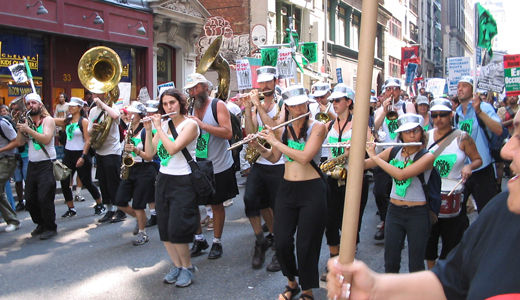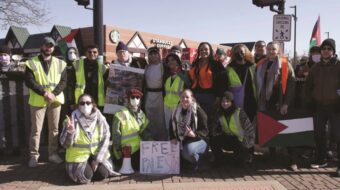
New York City is a true-blue town, but the GOP decided to hold its 2004 Republican National Convention there as a reminder to the nation of 9/11. Of course the GOP did not dwell on the fact that the largest terrorist act in U.S. history happened on Pres. George W. Bush’s watch despite several warnings his administration chose to ignore.
Protest activity against the convention and Bush’s re-nomination included a broad range of marches, rallies, performances, demonstrations, exhibits, and acts of civil disobedience. Hundreds of groups organized protests, including United for Peace and Justice (UPJ), a coalition of more than 800 anti-war and social justice groups. Before the week had ended, over 1800 individuals were arrested by the authorities, a record for a political convention in the U.S. Ninety percent of those charges were eventually dropped.
Banner drop, ACT UP, Critical Mass
The public face of activism began on Thurs., Aug. 26, when four people hung a banner more than a dozen stories above the ground over the front of the Plaza Hotel. The banner, measuring 60′ wide and three stories high, said “Truth,” with an arrow pointing toward Central Park, where the UPJ march would take place, and “Bush,” with an arrow pointing the other direction, toward Madison Square Garden (MSG), the convention site. The four climbers were arrested and the banner was removed by the police.
Twelve activists from the AIDS Coalition to Unleash Power (ACT UP) staged a naked protest in front of MSG, demanding debt cancellation for poor countries. They took their clothes off in the crosswalk, stopping traffic, as they joined hands and began chanting, “Bush, Stop AIDS. Drop the Debt Now!” They told “the naked truth” about Bush’s inadequate global AIDS policies, arguing for debt cancellation as a top priority. Several protesters – arrested, with all charges later dropped – later became subjects in photographer Richard Avedon’s last project, published in the New Yorker.
Nearly 6000 participants took part in the Critical Mass environmental bicycle ride on Fri., Aug. 27th. The monthly ride prior to this had attracted about 1500 riders. Police blockaded roads and arrested 264 people on the ride, charging them with disorderly conduct and holding them in custody for up to 72 hours.
Among the largest protests in U.S. history
On Sun., Aug. 29, UPJ organized the main march of the week, among the largest protests in U.S. history, in which protesters marched past MSG. The march included hundreds of separate contingents as well as individual marchers. Citizens, veterans and clergy held a procession of 1000 full-scale flag-draped coffins commemorating the fallen U.S. troops (so far). Estimates of crowd size ranged from 120,000 (a police spokesman) to over 500,000 (organizers, plus a second police source). In March 2007 NYPD Deputy Commissioner Paul Browne stated about the RNC protests: “You certainly had 800,000 on August 29.”
Michael Moore, Jesse Jackson, Congressman Charles Rangel, and a father who had lost his son in Iraq were among the speakers at the pre-march press conference. The march lasted six hours; the lead contingent finished the route at Union Square long before thousands of people could even move from the starting point. The NYC government, under Republican Mayor Michael Bloomberg, had earlier denied the protesters a permit to hold a rally in Central Park following the march, citing concern for the park’s grass, but organizers refused and encouraged people to go there anyway. “Only” 200 arrests were made that day, most after the march had concluded. For the most part, the march proceeded peacefully and without violence.
More marches, civil disobedience
On Mon., Aug. 30, Still We Rise, a coalition of 52 NYC-based community organizations for the poor and people of color marched from Union Square to MSG, and held a rally. At 4 pm, the Poor People’s Economic Human Rights Campaign, a national coalition involving over 60 organizations, held a rally at the UN’s Dag Hammarskjold Plaza. Many of these demonstrators had been living in a “mobile Bushville” which settled in Brooklyn a week before the Convention. A plainclothes police detective drove his scooter at 20 mph into the crowd, hitting and injuring people. The crowd tried to stop him, upon which police made several arrests (for assaulting a police officer) and deployed tear gas.
A group called the A31 Action Coalition called for massive civil disobedience on Tues., Aug. 31. About 1000 people, members of Code Pink and others, gathered in front of Fox News Channel’s NYC headquarters and held a “Fox News Shut-Up-A-Thon,” protesting Fox’s lack of balance and deriding it as a GOP propaganda arm. Protesters from the War Resisters League were arrested en masse just as they began their march from the World Trade Center up to the RNC convention. Others who got closer to the convention did a “die-in” in the street, where 54 more were arrested.
Several protesters were able to sneak into MSG and disrupt the speakers at the podium. Anti-war activists from Code Pink disrupted primetime addresses three nights in a row and twice during Bush’s acceptance speech. The father of one of the first U.S. servicemen killed in Iraq was ejected after holding up a sign that read, “Bush Lied. My Son Died.”
Agents provocateurs and lawsuits
The New York Times reported that the police not only videotaped and infiltrated protests, but also acted as agents provocateurs. NYPD officers traveled as far away as Europe and spied on people there who planned to protest at the RNC.
Along with the nonviolent protesters, police swept up many innocent bystanders in mass arrests who were required to show ID’s or face arrest without charges. Police created what one lawyer described as the city’s “own little Guantanamo on the Hudson,” the three-story, block-long Pier 57 that the city converted into a temporary prison – overcrowded, dirty, and contaminated, and unfit for detention of human beings.
The City reportedly refused to release the prisoners until a judge threatened to fine it for every extra hour every prisoner would spend in prison. Victims of the arrests filed lawsuits against the City of New York; it was determined from video evidence that the charges of resisting arrest in most cases were completely fabricated.
Events surrounding the RNC convention galvanized the broad opposition to the Bush agenda. But the movement for the Democrat John Kerry did not succeed. The day after Bush was “re-elected” (the veracity of the vote in the critical swing state of Ohio is still highly suspect), thousands of sad-faced Americans posted their pictures on the Internet with signs announcing to the world, “We tried. I’m so sorry.”
Adapted from Wikipedia and other sources.
Photo: Radical drum corps and marching bands, such as the Rude Mechanical Orchestra shown here, were a common sight at the RNC protests. Licensed under Public Domain via Commons.












Comments